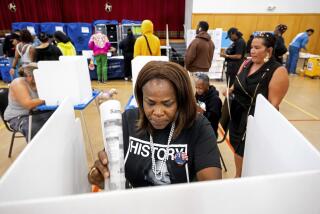An American Moment
- Share via
WASHINGTON — If I should need to name, O Western World, your powerfullest scene and show,
‘Twould not be you, Niagara; nor you, ye limitless prairies; nor your huge rifts of canyons, Colorado;
Nor you, Yosemite . . .
I’d name--the still small voice vibrating--America’s choosing day . . .
Texas to Maine--the prairie states--Vermont, Virginia, California,
The final ballot-shower from East to West.
--Walt Whitman, “Election Day, November 1884”
*
Election day was more fun in the 19th century--and not only because we had a national poet to glorify it. In those days, citizens trooped to the polls for a tribal rite, a communal act rather than the almost furtive individual votes we cast today.
Party membership was hereditary, like religion. Ballots often came in distinctive shapes, so party bosses knew who voted (and how). In some precincts, voters were given a dollar for coming to the polls; in others, saloons served free drinks to those who voted the right way.
In November 1884, a whopping 78% of eligible voters produced the shower of ballots that sent Grover Cleveland to the White House. And that wasn’t a record: the election of 1876 drew 82% of the voters. (In that one, Rutherford B. Hayes won the electoral vote even though he narrowly lost the popular vote--a precedent that could come in handy this year.)
Today, in West Virginia, the bars are closed on election day, the sad byproduct of well-intentioned reform. In New York, the bars are open, but voters no longer have the fun of using Tammany’s old-fashioned voting machines, the ones with massive steel levers that allowed you to vote the straight party ticket with a single pull, ka-chunk!
And in California, with its punch cards and 74-page Voter Information Guide, deciphering the propositions is about as much fun as taking the SAT. (It could be worse; Oregon’s voter guide is 376 pages, and that’s only Volume 1.)
It’s no wonder only about half of the nation’s eligible voters are expected to show up Tuesday for the first national election of the new millennium. Voting has become too much like homework.
That’s not the only reason fewer Americans come out to the polls. Harvard’s Robert D. Putnam argues that voting is only one of many forms of communal activity--from neighborhood associations to bowling leagues--that are in decline.
“It’s not just voting,” he says. “Actually, voting is down less than going to meetings about public issues or joining organizations.” But voter turnout is still the most measurable index of the vigor of our civic life.
Turnout has been waning, off and on, ever since 1960, when the Kennedy-Nixon race achieved the modern high-water mark of 63%. The 1996 campaign (Bill Clinton vs. Bob Dole) slumped to a record low of 49%. Turnout in off-year congressional elections is even lower; in 1998, just over 36% of the voting-age population came out. That’s a smaller percentage of Americans than watched the Super Bowl (43%), went to church on Easter (50%) or planned a Thanksgiving dinner (87%).
Yet if turnout is down, fairness is up--and maybe quality too.
Those big numbers from the 19th century ignore the fact that more than half the population was prohibited from voting at all: women, African Americans and Native Americans. My grandmother walked precincts for Woodrow Wilson in Bangor, Maine, in 1916, but she couldn’t vote for him; the 19th amendment didn’t go into effect until 1920. In the South, Jim Crow laws disenfranchised African Americans until the federal Voting Rights Act of 1965.
Yet many whose grandparents fought to win the vote have failed to use it. Turnout is especially low among the young. (Even MTV’s alarming rule of thumb--that 80% of the nation’s 80-year-olds vote, but only 20% of its 20-year-olds do--hasn’t brought them out.)
So by voting, you become a member of an exclusive club: the minority of citizens, an elite group of 100 million or so, who choose our leaders. It’s a club that is disproportionately white, elderly, educated and affluent--but still open to any citizen 18 or older.
Some scholars and politicians worry about that. How solid is a democracy when a minority makes the big decisions? But there may be a silver lining: When people don’t vote, it’s partly because they are happy with the way things are going.
After all, it’s easier to register and vote than ever before. “Motor voter” laws have made registration difficult to evade, but haven’t succeeded in raising turnout.
When the Census Bureau asked nonvoters in 1998 why they didn’t go to the polls, the most frequent answer was “too busy.”
That’s why many reformers have proposed changing election day from Tuesday to Sunday, as in many European countries. But being “too busy” extends beyond election day. Putnam believes that our decline in civic activism stems not so much from post-Watergate disaffection as from two-career families and long commutes--in other words, “too busy.”
Making election day a holiday and serving free beer wouldn’t solve those problems--but it might be worth a try. With any luck, a proposition to that effect might even turn up in next year’s Voter Information Guide.
More to Read
Get the L.A. Times Politics newsletter
Deeply reported insights into legislation, politics and policy from Sacramento, Washington and beyond. In your inbox three times per week.
You may occasionally receive promotional content from the Los Angeles Times.










